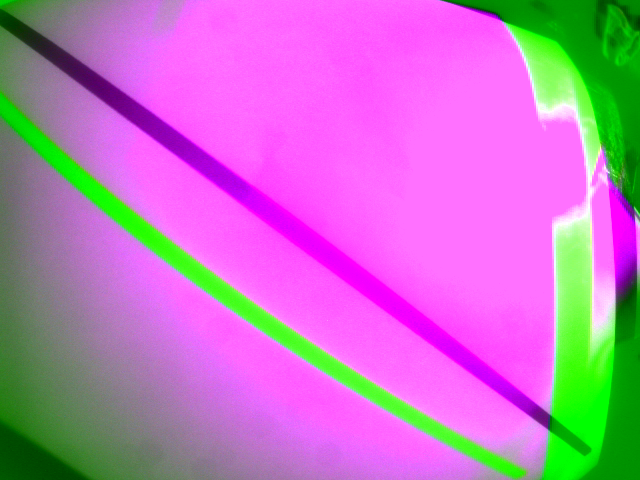Hi there,
I have a LI-USB30-V024STEREO board which interlaces the grayscale image into a single image. I am reading the images from the two cameras and displaying it into several windows, including the original image, but am unable to properly grab the gray-scale video from the source.
I have gotten some information and code from Leopard Imaging, but I think there is still a disconnect. They have provided to me what they are telling me is required to extract the two images from a frame. I have included the code below as well as before and after images of a frame. I am calling their code from ImageProcessing::process(). Any help you may provide would be most appreciated.
Raw, original image:

Processed Image:

#include "ImageProcessor.h"
#include "../handlers/menu/Menu.h"
#include "../utils/WindowUtils.h"
#include <vector>
#include <iostream>
#include <opencv2/highgui/highgui.hpp>
#include <stdio.h>
#include <SDL/SDL.h>
using namespace cv;
using namespace std;
string ImageProcessor::theWindowName = "Video";
ImageProcessor::ImageProcessor()
: videoCapture(0), myScreen(0), myFrameNumber(0) {
isRunningX = WindowUtils::isRunningX();
if (!videoCapture.isOpened()) {
cout << "Cannot open the video cam" << endl;
}
if (isRunningX) {
namedWindow(theWindowName.c_str(), CV_WINDOW_FULLSCREEN);
cvNamedWindow(theWindowName.c_str(), CV_WINDOW_NORMAL);
cvSetWindowProperty(theWindowName.c_str(), CV_WND_PROP_FULLSCREEN, CV_WINDOW_FULLSCREEN);
} else {
SDL_Init(SDL_INIT_EVERYTHING);
SDL_ShowCursor(0);
}
}
#define BYTE uchar
#define WORD ushort
#define TRUE 1
#define FALSE 0
static unsigned short linear_to_gamma[65536];
static double gammaValue = -1;
static int gBPP = 0;
void bayer_to_rgb24(uint8_t *pBay, uint8_t *pRGB24, int width, int height, int pix_order);
int raw_to_bmp_mono(BYTE* in_bytes, BYTE* out_bytes, int width, int height, int bpp,
bool GammaEna, double gamma);
bool ImageProcessor::process(Mat& matOut) {
// Leopard Imaging
unsigned char* ptr = (unsigned char*) malloc(myMat.cols * myMat.rows * 3);
unsigned char* ptr2 = (unsigned char*) malloc(myMat.cols * myMat.rows * 3);
bayer_to_rgb24(myMat.data, ptr, myMat.cols, myMat.rows, 1);
raw_to_bmp_mono(ptr, ptr2, myMat.cols, myMat.rows, 8, true, 1.6);
int i = 0;
for (int row = 0; row < matOut.rows; row++) {
for (int col = 0; col < matOut.cols; col++) {
Vec3b colorVect;
colorVect.val[0] = ptr2[i];
colorVect.val[1] = ptr2[i];
colorVect.val[2] = ptr2[i];
matOut.at<Vec3b>(Point(col, row)) = colorVect;
i+=2;
}
}
if (myFrameNumber == 10) {
writePngImage("/tmp/image.png", matOut, false);
writeInfo("/tmp/image.csv", matOut, false);
cout << "image snapped" << endl;
}
myFrameNumber++;
free(ptr);
free(ptr2);
}
void ImageProcessor::writePngImage(const string & fileName,
const Mat& mat, bool isColor) {
vector<int> compression_params;
compression_params.push_back(IMWRITE_PNG_COMPRESSION);
if (isColor) {
compression_params.push_back(9);
} else {
compression_params.push_back(3);
}
try {
imwrite(fileName, mat, compression_params);
} catch (...) {
fprintf(stderr, "Exception converting image to PNG format\n");
}
}
void ImageProcessor::writeInfo(const std::string & fileName,
const Mat& mat, bool isColor) {
FILE* file = fopen(fileName.c_str(), "w");
uchar* ptr = mat.data;
// write the header row
for (int col = 0; col < mat.cols; col++) {
if (isColor) {
fprintf(file, "%3d[0]\t%3d[1]\t%3d[2]", col, col, col);
} else {
fprintf(file, "%3d[0]\t%3d[1]", col, col);
}
if (col < mat.cols - 1) {
fprintf(file, "\t");
}
}
fprintf(file, "\n");
int val = 2;
switch (val) {
case 1:
// write the data using the class
for (int row ...
(more)